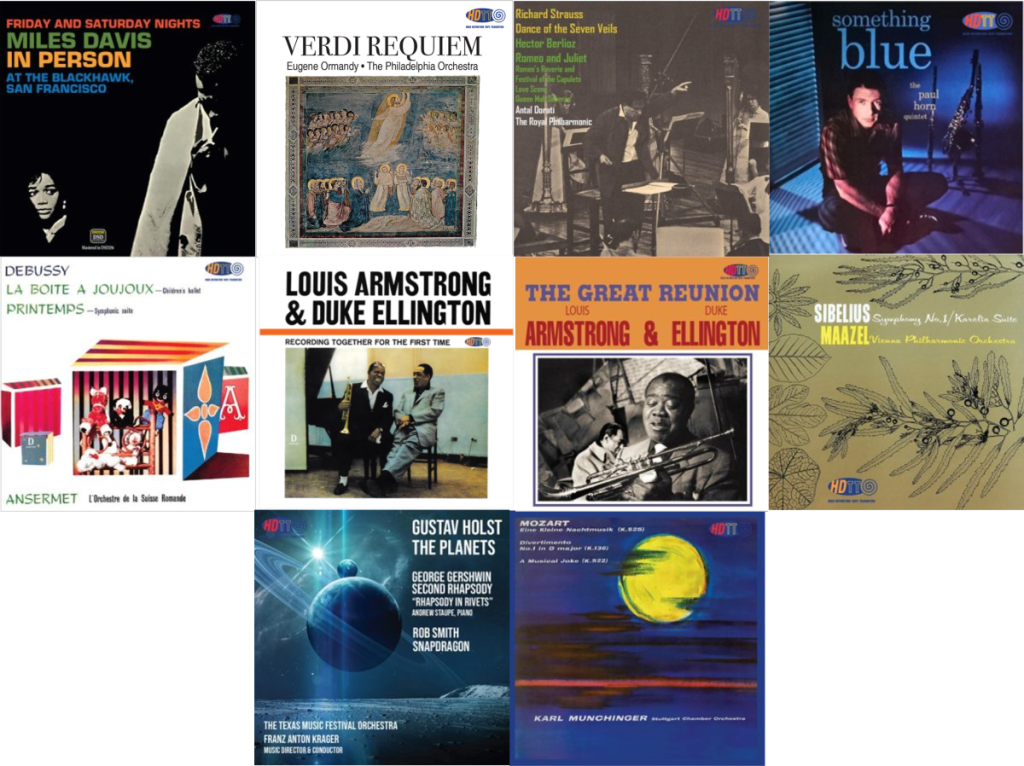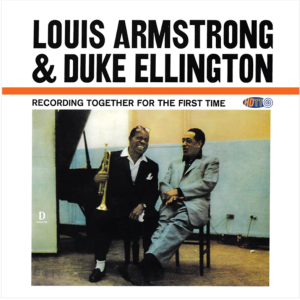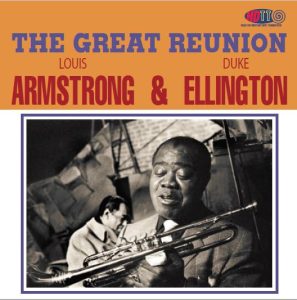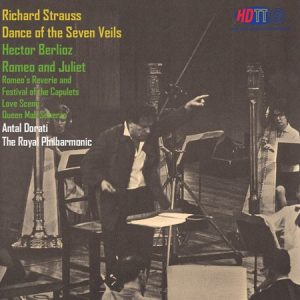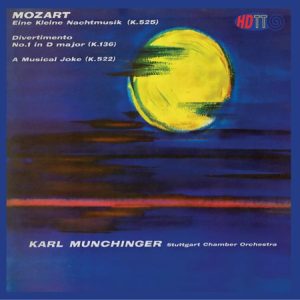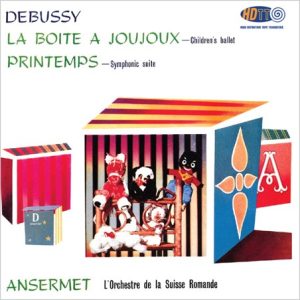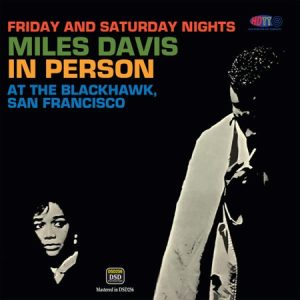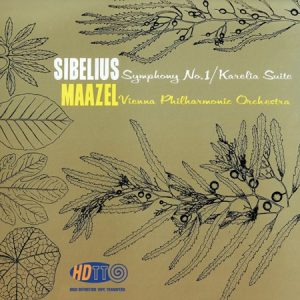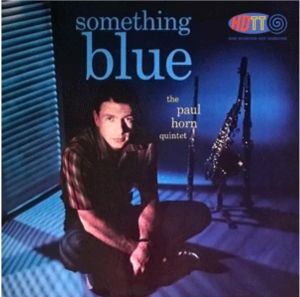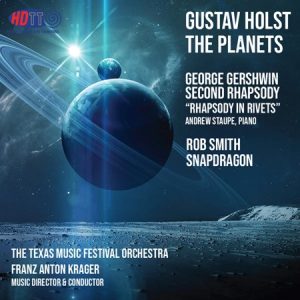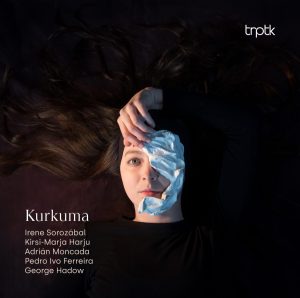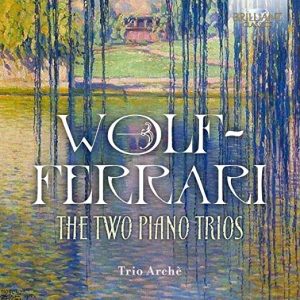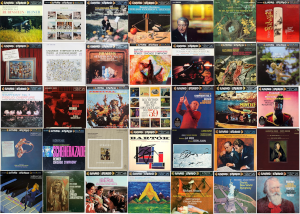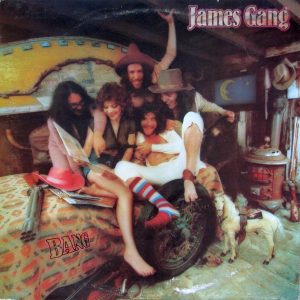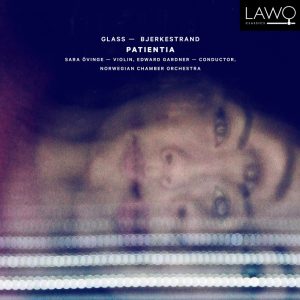High Definition Tape Transfers (HDTT) continues delivering reissues of iconic vintage albums in high resolution sonics that are simply "to die for" in their wonderfulness. Each few weeks, I think "It can't get any better than this" and then it does! Bob Witrak continues to work through an incredibly deep resource of tapes and LPs reflecting of some of the most highly regarded vintage jazz and classical albums from the 1950s through 1960s. This most recent trove of reissues are all dream recordings (both musically and sonically) that I'm pleased to suggest to you.
Louis Armstrong & Duke Ellington - Recording Together For The First Time. HDTT 1961 2023 (DSD256, DXD) HERE
This has always been one of my favorite albums. Armstrong and Ellington performing together just sound so easy and natural with each other—it amazes me that this is the first time they'd recorded together. This transfer from a 2-track 15ips tape is just a marvel of excellence in it's clarity, detail and frequency extension. The entire group of performers has simply come to life here in my listening room.
If you listen to vinyl and you have the excellent original LP or one of the even better Classic Records reissues (either 33 or 45 rpm), you can pass this by. But if you listen to digital only these days, or you have any of a plethora of lesser LP reissues, this high resolution digital release from HDTT is a "must have." I could go on and on about various aspects of the excellence of the sound quality, but I'll simply stop and say: just get it—you won't be disappointed.
Follow-up: I've now had the opportunity to compare this HDTT reissue to a couple other digital releases from Mobile Fidelity and Classic Records as double albums including both Recording Together For The First Time and The Great Reunion (which is also available from HDTT in an excellent transfer). Both of these are lower rate PCM releases and I don't know what source was used. Neither has the natural sound quality of the HDTT. With the HDTT, both voice and instruments have texture, depth and resonance—just like one would expect from good analog. And the piano on the HDTT transfer really sounds like a piano, which is not always the case with the other digital releases. For my ears and musical priorates, there is simply no comparison. The HDTT is the release to get.
The Great Reunion, Louis Armstrong & Duke Ellington. HDTT 1963 2018 (Pure DSD256) HERE
Another must have release to go along with Recording Together for the First Time. Everything I said about the first album (see above) applies here, and possibly to a greater degree. I don't see how anyone could be disappointed with these two Ellington and Armstrong reissues from HDTT.
Strauss Dance Of The Seven Veils, Berlioz Romeo Juliet, Antal Dorati, The Royal Philharmonic. HDTT 1962 2023 (DSD256, DXD) HERE
Spectacular performances by Dorati and the RPO. And simply a superb recording by the legendary Decca recording engineer Kenneth Wilkinson in this partnership with Charles Gerhart for Readers Digest. This entire Wilkinson/Gerhart series of Readers Digest is over-the-top excellent. And this recording is among their best.
The orchestral playing is dynamic and muscular, but filled with moments of great lyrical beauty. The violins can sound a bit sharp, and overall it sounds like the technology of the early '60s. But still wonderful. Wilkinson captures it all and I've just been basking in the the glow of this recording.
The transfer by HDTT is at their usual very high standards: utterly clean, virtually noise free, in full dynamic range and frequency extension. Here's to hoping they you can continue giving us still more recordings from the Readers Digest series!
Mozart Eine Kleine Nachtmusik, Divertimento, A Musical Joke, Karl Münchinger, Stuttgart Chamber Orchestra. HDTT 1960 2023 (DSD256, DXD) HERE
Now here is a nostalgic journey back to the early 60s—Karl Munchinger, who brought so many wonderful recordings via the Decca European recording team. Listening again today, these performances have surprising vitality and I'm impressed by how well they have survived the years.
This transfer by HDTT is another in their Vinyl Records Restoration series and is sourced from a London Blueback LP. The sonic results are simply very very good: clean, detailed, virtually noise free. These VRR series transfers are continuing to demonstrate the high technical skill and great care that the HDTT team is applying to these releases. I'm in that place of saying "If back in the day you enjoyed these London Bluebacks (as I did), I think you will equally value this excellent transfer." I'm certainly enjoying it!
Debussy La Boîte À Joujoux, Printemps, Ansermet, L'Orchestre De La Suisse Romande. HDTT 1957 2023 (DSD256, DXD) HERE
This is the classic minimally mic'd Decca sound from the European recording team of Roy Wallace with producer James Walker. Transferred from an original Decca LP, recorded 1957, this is yet another very enjoyable release in HDTT's Vinyl Record Restoration series. Ansermet is in top form here capturing every nuance of Debussy's phrasing, tonal shifts, and changes in volume. The music flows, weaves, and rolls with a subtle but captivating effervescence of color that is pure Debussy delight. And in places, like the "La Bergerie A Vendre - Apres Fortune Faite" (track 3), it fairly rollicks along.
The many excellences of this 1957 Decca recording are clearly in evidence on this exceptionally clean, clear transfer from the LP. All of the warmth, delicate harmonics, deep resonance of the low strings, are cleanly and clearly captured. The purity and delicacy of the high frequencies is a particular delight. Yes, it sounds like a 1957 recording, but for how many decades have we loved the sound of these early Decca LPs? For me, listening to this new transfer from HDTT in DSD256 is like returning home to great analogue sound. It's just a beautiful release!
Miles Davis In Person Friday And Saturday Nights At The Blackhawk Complete. HDTT 1961 2023 (Pure DSD256) HERE
When I just close my eyes and a happy smile fills my face, I know I'm enjoying an album. And that is exactly what happened as I launched this delicious reissue from HDTT. And the enjoyment continued as the group played on. If you are not already familiar with this album, this two-night stand at The Blackhawk in San Francisco is considered by many to mark a watershed in jazz history. Jazz critics have often described it as transforming the American musical landscape. For me, it is simply GREAT MUSIC supremely well performed by a terrific group of musicians.
Two full nights of Miles Davis captured live in his prime at an intimate jazz club. In 1961, Davis, pianist Wynton Kelly, bassist Paul Chambers, tenor saxophonist Hank Mobley, and drummer Jimmy Cobb recorded at San Francisco's legendary Blackhawk. Originally released as two LPs, this HDTT release is the complete set—essentially a double album.
The 15ips 2-track tape from which HDTT made this transfer must be superb because the transfer is among the best sounding jazz reissues HDTT has delivered to us. In its Pure DSD256 garb to which I'm listening, the sound quality is excellent—just wonderfully immersive in all it's simple stereo beauty.
Transferred from a tape to Pure DSD256, I'm listening to as close to an exact copy of this marvelous tape as it is currently possible to achieve, and the sound quality is excellent. Just exceedingly, wonderfully immersive in all it's simple stereo beauty. No matter what other digital reissues of this recording you may have, I'm convinced this HDTT DSD256 reissue will knock your socks off. If you listen to digital recordings and value sonic excellence, this is the release you should have in your collection. It's completely ensorcelled me.
Note: The CD Box Set brings the complete sessions from both Friday and Saturday nights (29 tracks), and includes "On Green Dolphin Street." This reissue does not because they are not included on the vintage source tape used to make this transfer. So, go to the CD Box for completeness, but come to the HDTT to experience the full wonderfulness of the sound quality that was captured on tape those evenings.
Sibelius Symphony No 1, Karelia Suite, Lorin Maazel, Vienna Philharmonic Orchestra. HDTT 1963 2023 (DSD256, DXD) HERE
Early Decca and gorgeous. Just shows our recording technology has not developed a whole lot beyond this John Culshaw, James Brown & Gordon Parry recording of 1963. Another really nice transfer by HDTT from an original London LP pressing. The sound quality is just luscious—deep sweet lovely strings, excellent dynamics, superb soundstage, and dead quiet. This is one of the classic performances of the Sibelius Symphony No. 1 and should be in every serious classic music lover's library. What a wonderful new addition to my library in this very excellent digital transfer. Thank you, HDTT!
Later Update... I've now had a chance to compare this reissue to the highly regarded Esoteric SACD which sells for crazy prices over on Discogs. If you have the Esoteric consider yourself very lucky because it truly is excellent. But, overall, I like this HDTT reissue better. Irrespective of the source for each, the HDTT sounds more open and resolved on my playback system, and the Esoteric has a bit of harshness in the strings that the HDTT does not have. If you don't already have the Esoteric, buy this HDTT reissue. I can't imagine anyone being disappointed in the sound quality of the DXD or DSD256 versions.
Bottom line... If you have been shying away from these Vinyl Record Restoration series releases from HDTT, you are losing out on some great music and some excellent sound quality.
Something Blue by The Paul Horn Quintet. HDTT 1960 2021 (DXD, DSD128) HERE
Sometimes I forget to tell you about things, and I apologize. Today an online forum thread caused me to remember this album and pull it out for another spin. It's terrific. A bit obscure, but it shouldn't be.
Recorded in March 1960 by Hi-Fi Jazz, this album has a very upbeat sound that is captured in nice resolution and excellent detail. Paul Horn in this period was an adventurous bop-based improviser trying to create an alternative to the hard bop music of the era. Horn plays alto sax, flute and clarinet on six complex originals (four are by the leader) in a quintet with vibraphonist Emil Richards, pianist Paul Moer, bassist Jimmy Bond, and drummer Billy Higgins. The results are a set of improvisations filled with tricky movement and some unusual time signatures, all of which are stimulating and rarely laid back.
New York born jazz flute player Paul Horn first rose to fame when he moved to California to play with Chico Hamilton's quintet from 1956 to 1958. By 1960 he was an established west coast session player working with jazz greats like Nat King Cole, Tony Bennett and Duke Ellington.
Holst The Planets, Gershwin Second Rhapsody, Smith Snapdragon, Franz Anton Krager, The Texas Music Festival Orchestra. HDTT 2023 (24/129kHz) HERE
A masters class in orchestra recording technique, this is a minimally mic'd, very direct recording that shows what is possible to achieve. No futz, no muss. Just the sound as heard at the conductor’s podium from a combination of 5 omni-directional Neumann and Peluso omnidirectional condenser microphones, one per channel. I'm listening to the 2-channel mix, but the multi-channel version is also available for any surround sound aficionados.
Producer and recording engineer John Proffitt's recordings are always eye-opening in the utter clarity of soundstage and orchestral detail that he achieves with his very minimalist miking philosophy. No phase distortion, no wandering images—just rock solid definition of musicians on the stage. And the dynamic range is tremendous. Yes, I could wish for a higher resolution original recording, but this is still supremely good. If you want to understand what is possible with just a few microphones carefully placed (and what the early Decca recording teams were achieving 60+ years ago), listen to any of the John Proffit recordings here at HDTT.
The Texas Music Festival Orchestra is a truly fine ensemble and their performances are always very good, as they are here.
Why would I wish for yet higher resolution in the original recording? As with all the PCM recordings 24/96 and 24/192 resolution, it lacks the ultra-fine resolution and continuousness of the best analog or DSD256 recordings. John's recordings are sooo good, I just wish he were recording in DXD or, better yet, DSD256 to fully realize their sonic potential. But, they are still a quite amazing demonstration of great recorded orchestral sound.
Verdi Requiem, Eugene Ormandy, The Philadelphia Orchestra. HDTT 1964 2023 (DSD256, DXD) HERE
With a superlative cast of soloists, including Maureen Forrester, George London, and Richard Tucker, this is a performance of Verdi's famous Requiem to grab one's attention. As one commentator pointed out, this is a recording that just flew under the radar. And that is unfortunate because it is a glorious performance and an excellent recording. I've never been a great fan of Eugene Ormandy (sorry, I just missed that boat), but this is a performance worthy of his reputation as a great conductor.
While I am hugely fond of Reiner's great performance for RCA, this is a performance that could yet become my favorite. The soloist are outstanding, the chorus is marvelous, alert and alive, and the capture of the huge orchestral bass drum will drive your woofers crazy. It is a recording to turn up LOUD and then revel in the sound of it.
Recorded May 14-15, 1964 at the Manhattan Center, NYC, this transfer by HDTT comes from a 2-track 15ips tape. And it is up to HDTT's usual high standards: clean, virtually no background noise, huge dynamics, tremendous frequency extension. The Columbia recording team avoided the excessive spot-miking that so disturbs me in many of their recordings and the sound from the Manhattan Center has great balance and open airy reverberation that is well captured. (Fair warning: the dynamic range is wide open enough to cause some overload to one's speakers. So be cautious. If you hear distortion, lower the volume. It's likely your system overloading, but the recording does have a bit of microphone overload on the powerful soprano voices. Still, that can be almost unavoidable with these voices.)
In all, highly recommended.




